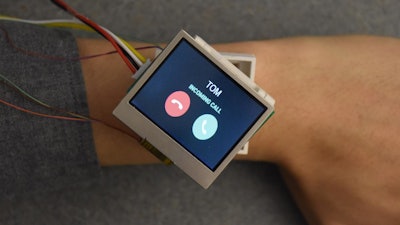
In an effort to make digital smartwatches more convenient for their users, researchers at Dartmouth College and the University of Waterloo have produced a prototype watch face that moves in five different directions.
With the ability to rotate, hinge, translate, rise and orbit, the model dramatically improves functionality and addresses limitations of today's fixed-face watches. The concept, named Cito, will be presented on May 10 at the ACM CHI Conference on Human Factors in Computing Systems in Denver, Colorado.
"Users want smartwatches that fit their lifestyles and needs," said Xing-Dong Yang, assistant professor of computer science at Dartmouth. "The Cito prototype is an exciting innovation that could give consumers even more great reasons to wear smartwatches."
Most smartwatch research primarily addresses how users can more easily input information. Cito, designed and engineered by Jun Gong, Lan Li, Daniel Vogel, and Yang, aims to remove awkward moments associated with using smartwatches by improving how the device presents data to the wearer.
Examples of watch movement - or actuation - include:
- Automatically orbiting around the wristband to allow viewing when the wrist is facing away from the user.
- Rising to alert the wearer of a notification if the user is playing a game.
- Hinging to allow a companion to view the watch face.
- Translating to reveal the watch face from underneath a shirt sleeve.
"Consumers will question the need for smartwatches if the devices are just not convenient enough. Cito proves the true potential of smartwatches and shows that they can be functional and fun," said Yang. According to a research paper submitted at CHI 2017, the five watch face movements can be performed independently or combined. Beyond making the watches more convenient for users, the technology can provide important benefits to wearers with physical disabilities or other impairments.
In developing the prototype, researchers conducted two separate studies to confirm the usefulness, social acceptability and perceived comfort of different watch movements and usage contexts.
With continued research, the team is planning to integrate innovations like an ultra-sonic motor to reduce bulk and increase battery life to make the actuated watch technology more practical.






















